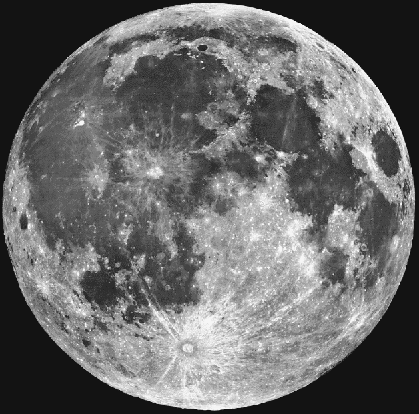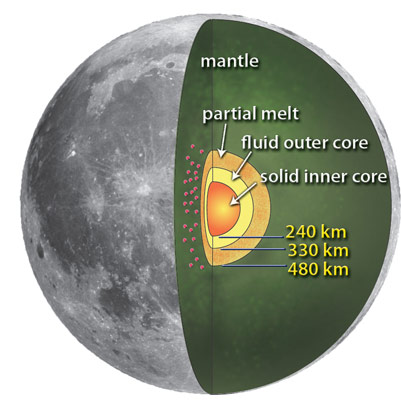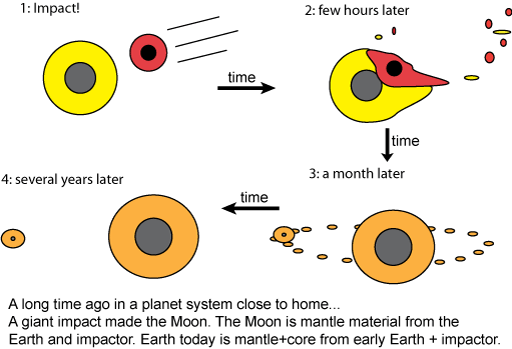
The Moon without a telescope.
This section gives a brief discussion of the large moons in the solar system and the characteristics of the rings found around all of the jovian planets. The best known moon is the only other object that humans have explored directly---the Earth's moon. I will discuss the Moon first and then move to the large moons of the jovian planets. The two moons of Mars and most of the moons of the jovian planets are small, rocky objects about the size of a large city or smaller. Most of them are probably asteroids that wondered too closely to the planet and got trapped by the planet's gravity.


The Moon also has large, dark smooth areas covering about 17% of the Moon's surface that people originally thought were seas of liquid water so they are called mare (Latin for ``seas''---they are what make out the face on the Moon). Now it known that the mare are vast lava flows that spread out over many hundreds of square miles, covering up many craters that were originally there. The mare material is basaltic like the dark material on the Earth's ocean crust and that coming out many of our shield volcanoes (e.g., the Hawaiian islands). Mercury also has maria but they are lighter in color because of the different chemical composition and they do not stand out from its heavily cratered areas.
Liquid water cannot exist on the Moon because of the lack of an atmosphere---the Moon has only about 1/6th the Earth's surface gravity. If there is any water to be found on the Moon, it will be in a frozen state in a place of constant shade such as deep craters near the poles. Recent missions have discovered some of those ice blocks near the poles (Clementine, Lunar Prospector, LCROSS). The ice blocks will be the source of water for any humans that decide to set up bases on the Moon.
The average thickness of the Moon's crust is between 34 and 43 kilometers thick. The strong tides from the Earth pulled the early Moon's liquid interior toward the Earth, so the far side's crust is thicker than the near side's crust. The thinness of the near side's crust is also why there are more mare on the near side than the far side. The near side was thin enough to be cracked apart when large asteroids hit the surface and formed the mare but the far side crust was too thick.
Our knowledge about the Moon took a huge leap forward during the Apollo missions. One main science reason for going to the Moon was to return rock samples to find about their ages and composition. Using their knowledge of geology gained from the study of Earth rocks, scientists were able to put together a history for the Moon. The Apollo astronauts also left seismometers on the Moon to detect moonquakes that can be used to probe the interior using seismology.
The Moon's density is fairly uniform throughout and is only about 3.3 times the density of water. A recent re-analysis of the Apollo seismic data shows that the Moon has a small iron-rich core made of three parts: a solid inner iron core 480 kilometers in diameter, a fluid iron outer core shell 90 kilometers thick, and a third part unique to the Moon that is a shell of partial melt about 150 kilometers thick (see also ASU link). The iron core also contains a small percentage of lighter elements such as sulfur. Further refinements of our view of the Moon's interior will undoubtedly occur as scientists analyze all of the gravity data from the recently-completed GRAIL mission.

The small core is a sharp contrast from planets like Mercury and the Earth that have large iron-nickel cores and overall densities more than 5 times the density of water. The Moon's mantle is made of silicate materials, like the Earth's mantle, and makes up about 90% of the Moon's volume. The temperatures do increase closer to the center and are high enough to partially liquify the material close to the center. Its lack of a large liquid iron-nickel core and slow rotation is why the Moon has no magnetic field.
Lunar samples brought back by the Apollo astronauts show that compared to the Earth, the Moon is deficient in iron and nickel and volatiles (elements and compounds that turn into gas at relatively low temperatures) such as water and lead. The Moon is richer in elements and compounds that vaporize at very high temperatures. The Moon's material is like the Earth's mantle material but was heated to very high temperatures so that the volatiles escaped to space.
The giant impact theory proposes that 50 million years after the Earth formed, a large Mars-sized object hit the Earth and blew mantle material outward, some of which later coalesced to form the Moon. Most of the mantle material from the Earth and the giant impactor combined to make a larger Earth. The Earth had already differentiated by the time of the giant impact so its mantle was already iron-poor. The impact and exposure to space got rid of the volatiles in the ejecta mantle material. Such an impact was rare so is was not likely to have also occurred on the other terrestrial planets. The just-formed Moon was only about 64,000 kilometers (40,000 miles) from the Earth and it has been spiraling away from us ever since (though, at an ever-decreasing rate). The tides the Earth experienced from the Moon at that early time was enough to raise solid ground 60 meters during high tide and the Earth was spinning much faster back then---one day was about five hours long.

The one "drawback" of the theory is that it has a lot of parameters (impactor size, speed, angle, composition, etc.) that can be tweaked to get the right result. A complex model can usually be adjusted to fit the data even if it is not the correct one (recall Ptolemy's numerous epicycles). But the giant impact theory is the only one proposed that can explain the compositional and structural characteristics of the Moon.
The images above are from paintings by one of the authors of the giant impact theory, William Hartmann. The first is at the time of impact and the second is five hours after the impact based on computer reconstructions of the impact. See Hartmann's online painting catalog for many more space art paintings.
![]() Go back to previous section --
Go back to previous section --
![]() Go to next section
Go to next section
last updated: June 6, 2019